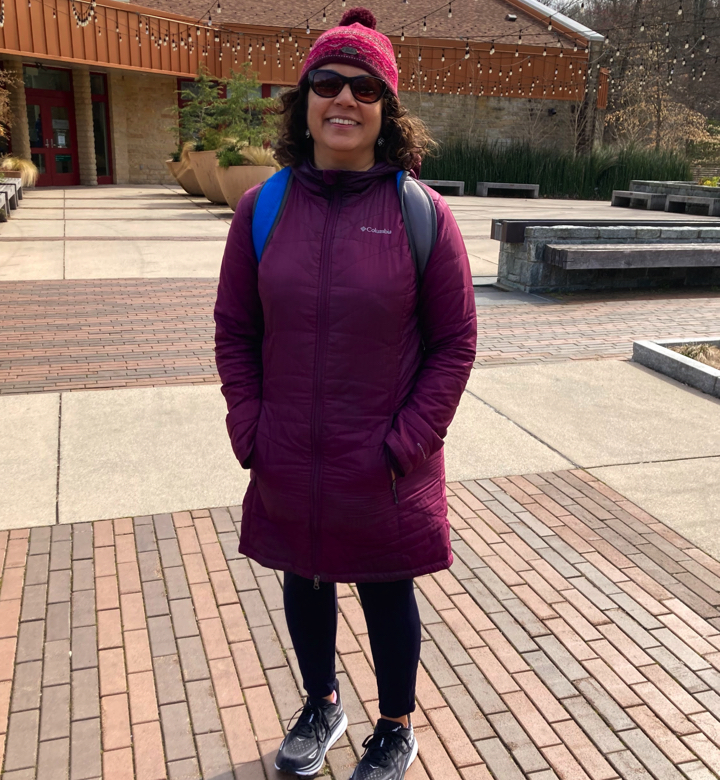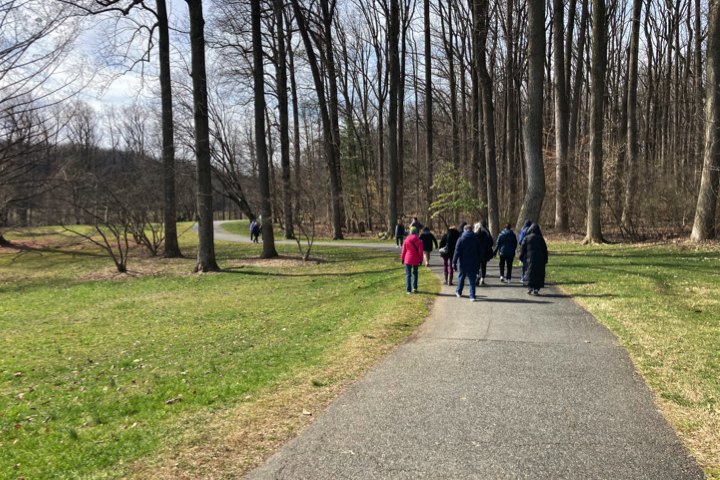WHEATON, Md. — There’s a bit of a damp chill in the air late on a Saturday morning in mid-March as 17 people — most of whom appear to be in their 50s or older — gather at a park in this Washington suburb. But they are not deterred.
The group is participating in the “Walk with a Doc” program, started in 2005 by Columbus, Ohio cardiologist David Sabgir, MD. On this morning’s walk in Wheaton, Asha Subramanian, MD, a co-founder of this “Walk with a Doc” chapter, begins by giving a 10-minute talk on ways to build healthy habits, including cutting up healthy foods in advance for snacking and “anchoring” a habit to something you do every day.
The group listened attentively and also passed around a clipboard with a sign-in sheet that included a short liability waiver at the top. After Subramanian finishes her brief talk, the group breaks up into smaller groups to complete a 1-mile walk on a paved trail in the park; some groups made the trip twice around. The whole event took about an hour.

Group Motivation
“We’re motivated to do it because we know there’s a group, and that’s motivational,” said Linda Mahler, 73. She and her husband David Mahler, 76, live in a nearby retirement community and have been coming to the walks for 3 years. “And we appreciate the doctor’s time. We might not walk ourselves, but we know the doctor’s waiting for us.”
She said she had learned from some of the doctors who have led the walks, like when one of the doctors brought a yoga mat and demonstrated how yoga could help improve core muscles. “One doctor suggested books I could use for my grandchildren, who are picky eaters … and I’ve made some friends.”
Sabgir said in a phone interview with MedPage Today that the idea was born in part from frustration.
“I was seeing a big difference in patients that were active — the lives they were leading, their quality of life — versus those that weren’t,” he said, reflecting on his residency and cardiology fellowship at Ohio State University. “So I thought, ‘Well, this will be easy. I’ll just get everyone on that path.'”
He would have great conversations with patients about what their favorite physical activity was, “and those conversations seemed very fruitful,” Sabgir continued. “I always left them energized and feeling like I had chosen the right career … and then when the patients came back for follow-up, whether it was at 6 months or 12 months, I [discovered I’d been] basically totally ineffective” and the patients hadn’t become physically active.
“I thought, ‘I’m going to be having this conversation for the rest of my career and it’s not working, and I don’t want to play this charade,'” he said. “It’s not doing anything.”
So Sabgir invited a patient to come to the park for a walk with him and his family. “I was trying to make it difficult for that first patient … I wanted this patient, honestly, to have to say ‘No’ to my face. So that’s how it started.”
Building Up Steam
“I’m not a person who believes in magic but … my nurse walked out of that room saying, ‘Hey, you know, my husband works on Saturday mornings. How about if I come and check blood pressures?’ and within a few days, we had numerous partner requests from people just wanting to be involved in it. And so we realized we had stumbled on something and we collected names in the office for about 6 months. The first walk was in April 2005,” he added.
The practice also began a patient newsletter — available on the Walk with a Doc website — that includes “funny, goofy” content along with wellness tips and other information.
Three years after Sabgir started the program, Cooking Light magazine published a few paragraphs about it, “and that led to requests from doctors around the U.S. to do it,” Sabgir said. The program caught the attention of General Motors, which contacted its insurer, Anthem, “and that led to it becoming a sponsor for 10 years … that allowed us to hire an executive director and develop a toolkit” for clinicians who wanted to start chapters. There are currently 528 chapters, including 130 outside the U.S., and the program reaches 37 countries. About two-thirds of chapters do a monthly walk — the minimum required — while another 25% do weekly ones, with the rest doing some interval in between.
Starting a chapter was free for the first 13 years, but now there is a $650 startup fee and a $250 annual maintenance fee; most of the money goes toward liability insurance, with the rest going to maintain the website and for other overhead, he said. However, the organization has a “very robust” scholarship program, so if someone wants to start a chapter in an underserved area and can’t afford to, Walk with a Doc will pay the cost.
In addition, if a hospital system wants to “co-brand” the program, Walk with a Doc charges $2,500 a year and uses that money for the scholarship program.
The program has spawned a lot of success stories, according to Sabgir: “I’ve led 500-600 walks and there’s almost something at every walk,” he said. “We have obvious weight loss stories,” although much of that is attributable to dietary changes.
One participant “was not active and eventually got to the point where he’s now running marathons. Then he and his family started taking vacations to national parks, and you need to be in decent shape to do some of the hikes. For them to be able to experience that … that gets me really excited,” he said. “And I’m most excited when people go from not doing anything to being able to walk a whole mile. That’s the whole reason we do this.”

A Unique Opportunity
Subramanian, a family physician, first heard about the program from Sabgir himself at a conference sponsored by the American College of Lifestyle Medicine. “He had a table in the exhibit hall, and I thought it was a really unique opportunity,” she said in a phone interview. “I’d never heard of a medical professional going into the community and leading walks.”
Subramanian is from suburban Maryland and works for Community of Hope, a community health clinic in Washington, D.C. that serves primarily homeless and low-income patients. Although the walks weren’t a good fit for the patients at her own practice, “I saw it as a community health event,” she said.
She met Aruna Nathan, MD, an internist in Kensington, Maryland, who also was interested in starting a chapter. They split the initiation fee — at that time $550 — and identified the park they would use, and did the first walk in October 2018. A little later they were joined by Marsha Seidelman, MD, who is also an internist in Kensington. As for marketing the walk, in addition to being listed on the organization’s website, “we used a little social media — a little bit of Facebook, Twitter, and that kind of thing,” Subramanian said. A total of 25 people showed up for the first walk.
“With my strong interests in lifestyle medicine and wellness/prevention, it was a win-win, even though they weren’t my actual patients,” she said in an email. “I really wanted to see where this activity would take me! It has led to interest from the county and we have participated in two Active Aging Week Events.”
-
Joyce Frieden oversees MedPage Today’s Washington coverage, including stories about Congress, the White House, the Supreme Court, healthcare trade associations, and federal agencies. She has 35 years of experience covering health policy. Follow
Please enable JavaScript to view the
